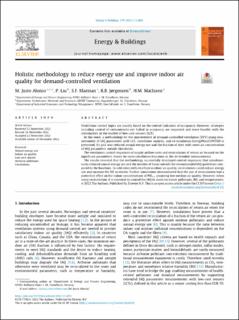| dc.contributor.author | Justo Alonso, Maria | |
| dc.contributor.author | Liu, Peng | |
| dc.contributor.author | Marman, Stine Flage | |
| dc.contributor.author | Jørgensen, Rikke Bramming | |
| dc.contributor.author | Mathisen, Hans Martin | |
| dc.date.accessioned | 2022-12-16T07:48:02Z | |
| dc.date.available | 2022-12-16T07:48:02Z | |
| dc.date.created | 2022-11-27T21:25:40Z | |
| dc.date.issued | 2022 | |
| dc.identifier.issn | 0378-7788 | |
| dc.identifier.uri | https://hdl.handle.net/11250/3038130 | |
| dc.description.abstract | Ventilation control logics are usually based on the control indicators of occupancy. However, strategies including control of contaminants not linked to occupancy are requested and more feasible with the introduction in the market of low-cost sensors (LCS). In this work, a methodology for the improvement of demand-controlled ventilation (DCV) using measurements of IAQ parameters with LCS, correlation analysis, and co-simulation EnergyPlus/CONTAM is presented. Its goal was reduced annual energy use and the fraction of time with room air concentration of IAQ parameters outside thresholds. The ventilation control sequences of supply airflow rates and recirculation of return air focused on the significant parameters chosen by cross-correlation functions in the de-trended measurements. The results revealed that the methodology successfully developed control sequences that simultaneously reduced annual energy use and the number of hours outside the recommended IAQ guidelines compared to the baselines. In cold cities with excellent outdoor air quality, recirculation could reduce energy use and increase the RH in winter. Further simulations demonstrated that the use of recirculation had a protective effect on the indoor concentrations of PM2.5, assuming low outdoor air quality. However, when using recirculation, it is essential to control the IAQ to avoid excessive pollutants, RH, and temperatures. | en_US |
| dc.description.abstract | Holistic methodology to reduce energy use and improve indoor air quality for demand-controlled ventilation | en_US |
| dc.language.iso | eng | en_US |
| dc.publisher | Elsevier | en_US |
| dc.rights | CC BY 4.0 | * |
| dc.rights.uri | http://creativecommons.org/licenses/by/ | * |
| dc.subject | Annual energy use | en_US |
| dc.subject | Indoor air quality | en_US |
| dc.subject | Low-cost sensors | en_US |
| dc.subject | Airborne pollutants | en_US |
| dc.subject | Correlations | en_US |
| dc.title | Holistic methodology to reduce energy use and improve indoor air quality for demand-controlled ventilation | en_US |
| dc.type | Peer reviewed | en_US |
| dc.type | Journal article | en_US |
| dc.description.version | publishedVersion | en_US |
| dc.rights.holder | © 2022 The authors | en_US |
| dc.source.volume | 279 | en_US |
| dc.source.journal | Energy and Buildings | en_US |
| dc.identifier.doi | 10.1016/j.enbuild.2022.112692 | |
| dc.identifier.cristin | 2081959 | |
| dc.relation.project | Norges forskningsråd: 257660 | en_US |
| dc.source.articlenumber | 112692 | en_US |
| cristin.ispublished | true | |
| cristin.fulltext | original | |
| cristin.qualitycode | 2 | |

